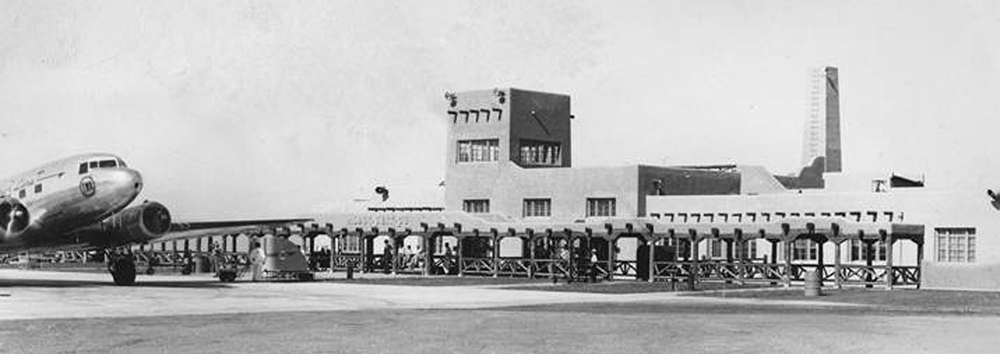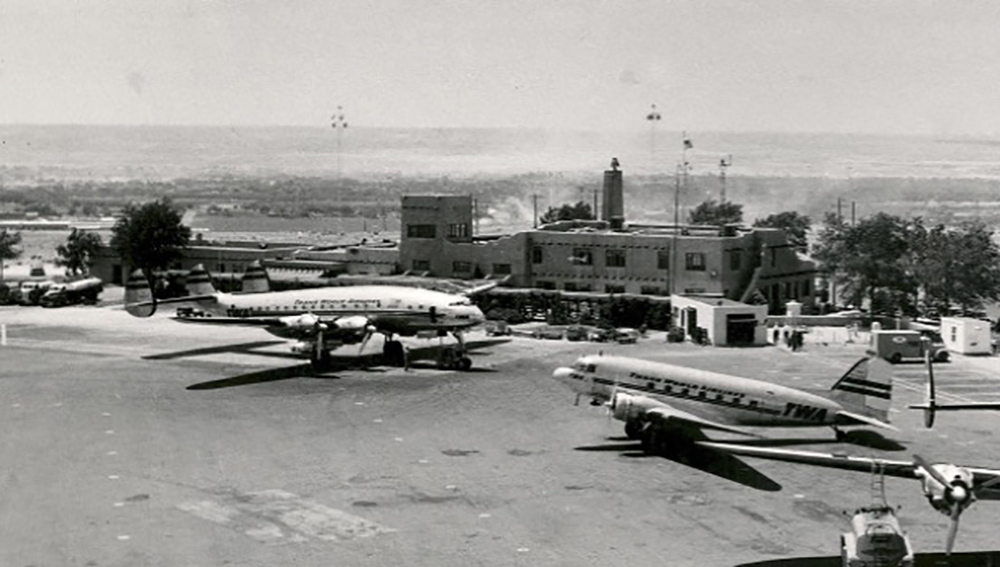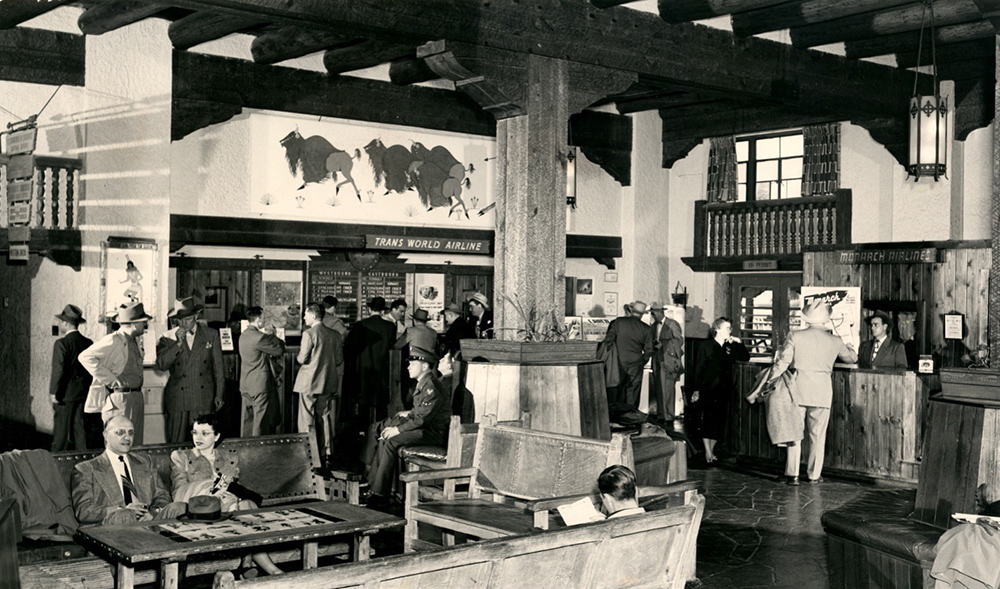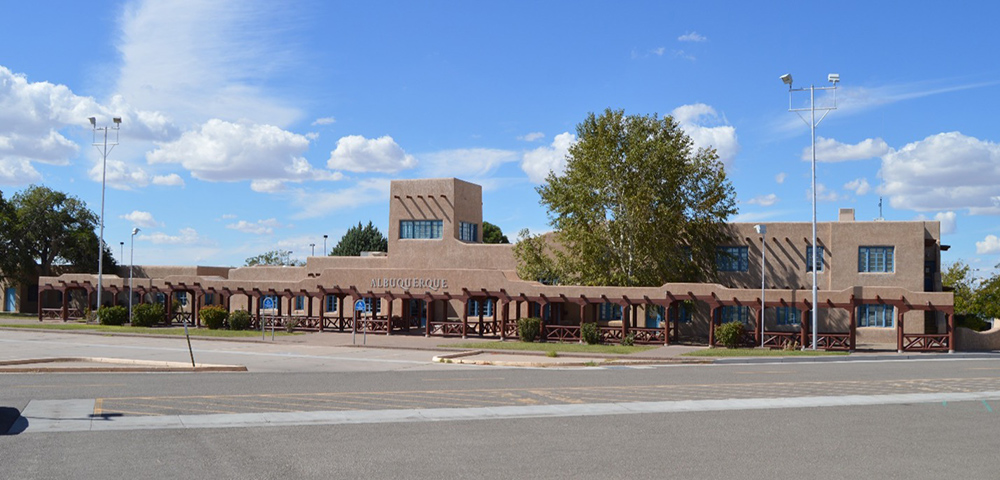Albuquerque Airport
Albuquerque Municipal Airport 1939-1965
Albuquerque first saw commercial airline service in 1929 when two carriers, Transcontinental Air Transport (TAT) and Western Air Express (WAE) both began service with east-west routes. A third carrier, Mid-Continent Air Express (MCAE) soon began a north-south route and Albuquerque became a crossroads for air travel in the Southwest. A privately owned airport was used on the cities’ east side for the first year then moved to a new airport, built by WAE, on Albuquerque’s west mesa. TAT and WAE merged in 1930 to become Transcontinental and Western Air, or “TWA”, and MCAE’s north-south route was later replaced by Continental Air Lines. In 1935, TWA and the City of Albuquerque decided that a new municipal airport was needed and could be constructed using money from a Works Progress Administration (WPA) grant.
Ground was broken in 1937 and the new $700,000 facility, designed by local architect Ernest Blumenthal, opened in July, 1939 complete with two paved runways, an adobe style terminal, and a large hanger designed to accommodate upcoming four-engine aircraft. TWA and Continental both moved their operations to the new airfield, named the “Albuquerque Municipal Airport”. The new airport, coded as “ABQ”, was built about four miles west of the original airport of 1929 and the site continues to be used today. The airport actually opened before completion as torrential summer monsoon rains had flooded the West Mesa Airport and its dirt runways. TWA, which later changed its name to Trans World Airlines, had a large part in building the new facility and the airline was in charge of operating the terminal until 1961. As the United States entered World War II in 1941, the city deeded the land to the Air Force and the Albuquerque Army Air Base was constructed just east of the terminal. The base was renamed to Kirtland Army Air Field in 1942 and again to Kirtland Air Force Base in 1947. The entire airport also became known as Kirtland Field. To date, the base and the civilian airport have shared the runways and certain facilities, one of only a few in the country to do so.
After the war, two more airlines began serving the airport, Monarch Airlines in 1947 and Pioneer Airlines in 1948. Monarch merged with other carriers to become Frontier Airlines in 1950 and Pioneer merged into Continental Air Lines in 1955. All carriers were flying mostly Douglas DC-3 aircraft at the time. The first commuter airline, Carco, also began in 1947 with flights to Los Alamos, New Mexico. By the late 1940’s, TWA began flying much larger four-engine Lockheed Constellations and Continental introduced larger Convair 240 aircraft. At some point in the 1940’s a second level was added to the northeast half of the terminal as well as an addition to the southwest side of the building. In the 1950’s another addition was built on the ramp side extending beyond the covered walkway. TWA began the first jet service to ABQ in 1961 with the Boeing 707 and the Convair 880 followed by the Boeing 727 in 1964. By the end of 1964, TWA was flying all jets at ABQ. Continental began flying the four-engine Vickers Viscount through ABQ in 1959 and briefly flew their Boeing 720 jet through the airport in 1962. Trans-Texas Airways began service in 1963 (becoming Texas International Airlines in 1969) which, along with Frontier, rounded out the first four legacy airlines to operate at the airport through the 1970’s. In 1961, the city of Albuquerque took over the physical operation of the airport, which had been previously done by TWA, and Clyde Sharrer became the first Director of Aviation, a position he held for twenty years. On January 3, 1963 the city took the lease of the land back from the Air Force and the commercial airport was renamed “Albuquerque Sunport” on April 17, 1963.
The city of Albuquerque more than doubled in population during the 1950’s while the airport was seeing tremendous growth. With TWA operating all jets and the other three carriers proposing jet service, a decision was made in the early 1960’s to build a new and much larger terminal. The new terminal was built just east of the original terminal, opening on November 12, 1965 at which time TWA, Continental, Frontier, and Trans-Texas Airways all moved their operations. The smaller commuter airlines including Carco remained at the old terminal for several more years. The old terminal was later named as the William P. Cutter Memorial Building after a local aviation pioneer and was used to house the Albuquerque Museum during the 1970’s. It was listed on the National Register of Historic Places by 1989. The building was refurbished in 2001 and is now used for office space by the Transportation Security Administration (TSA) while remaining open to the public.




